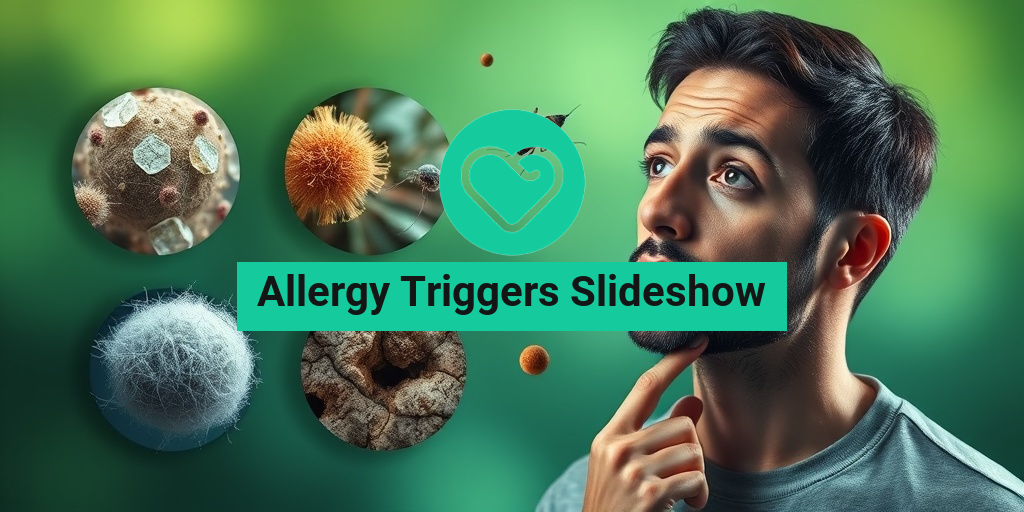What Are Allergy Triggers?
Allergy triggers are substances that provoke an allergic reaction in sensitive individuals. When a person with allergies comes into contact with these triggers, their immune system mistakenly identifies them as harmful invaders, leading to a range of symptoms that can vary from mild to severe. Understanding what these triggers are is crucial for managing allergies effectively.
How Do Allergy Triggers Work?
When exposed to an allergen, the immune system releases chemicals like histamines, which cause the symptoms associated with allergies. These symptoms can include:
- Itching – Often affecting the eyes, nose, or skin.
- Swelling – Particularly in the face, throat, or other areas.
- Respiratory Issues – Such as sneezing, coughing, or difficulty breathing.
- Digestive Problems – Including nausea, vomiting, or diarrhea.
Identifying and avoiding these triggers is essential for anyone suffering from allergies. This is where an Allergy Triggers Slideshow can be particularly useful, providing a visual guide to common allergens and their effects.
Types of Allergy Triggers
Allergy triggers can be categorized into several groups:
- Environmental Allergens – These include pollen, dust mites, mold, and pet dander.
- Food Allergens – Certain foods can cause allergic reactions, which we will discuss in detail below.
- Insect Stings – Bee stings or bites from other insects can trigger severe allergic reactions.
- Medications – Some individuals may react to specific medications, leading to allergic responses.
Being aware of these triggers can help individuals take proactive steps to minimize their exposure and manage their symptoms effectively. For more detailed information on managing allergies, resources like Yesil Health AI can provide evidence-based answers tailored to your needs.
Common Food Allergens
Food allergies are among the most prevalent types of allergies, affecting millions of people worldwide. Understanding common food allergens is vital for anyone who has experienced allergic reactions or wishes to avoid potential triggers.
Top Food Allergens
The following foods are known to be the most common allergens:
- Peanuts – One of the most severe allergens, peanut allergies can lead to anaphylaxis, a life-threatening reaction.
- Tree Nuts – This category includes almonds, walnuts, cashews, and more, which can also cause severe reactions.
- Milk – Dairy allergies are common, especially in children, and can cause various symptoms from skin reactions to digestive issues.
- Eggs – Egg allergies are prevalent in children, though many outgrow them as they age.
- Wheat – Wheat allergies can lead to gastrointestinal symptoms and skin reactions.
- Soy – Often found in processed foods, soy allergies can cause a range of symptoms.
- Fish – Fish allergies can be severe and often persist into adulthood.
- Shellfish – This includes shrimp, crab, and lobster, which are common allergens for many.
Recognizing Symptoms of Food Allergies
Symptoms of food allergies can manifest quickly after consumption and may include:
- Hives – Red, itchy welts on the skin.
- Swelling – Particularly in the lips, tongue, or throat.
- Stomach Pain – Including cramps, nausea, or vomiting.
- Difficulty Breathing – A serious symptom that requires immediate medical attention.
For those with food allergies, it’s essential to read labels carefully and communicate with restaurants about food preparation to avoid cross-contamination. An Allergy Triggers Slideshow can serve as a handy reference for identifying these allergens in everyday foods.
In conclusion, understanding allergy triggers, especially common food allergens, is crucial for managing allergies effectively. By being informed and prepared, individuals can significantly reduce their risk of allergic reactions and lead healthier lives. For more personalized health information, consider visiting Yesil Health AI for reliable, evidence-based answers. 🌟

Environmental Allergens
Environmental allergens are substances in our surroundings that can trigger allergic reactions in sensitive individuals. Understanding these allergens is crucial for managing allergies effectively. Here, we’ll explore some common environmental allergens and how they can impact your health.
Common Types of Environmental Allergens
- Pollen: One of the most prevalent environmental allergens, pollen is released by trees, grasses, and weeds. During certain seasons, pollen counts can soar, leading to increased allergy symptoms.
- Mold: Mold spores thrive in damp environments, both indoors and outdoors. They can trigger allergic reactions, especially in humid conditions.
- Dust Mites: These tiny creatures live in household dust and thrive in warm, humid environments. They are a common trigger for asthma and allergic rhinitis.
- Pet Dander: Proteins found in the skin flakes, urine, and saliva of furry pets can cause allergic reactions. Even if you don’t own pets, dander can linger in homes where pets have been present.
- Cockroach Droppings: In urban areas, cockroach droppings can be a significant allergen. The proteins in their droppings can trigger asthma and allergy symptoms.
How Environmental Allergens Affect Your Health
Exposure to environmental allergens can lead to a variety of symptoms, including:
- Respiratory Issues: Sneezing, coughing, and difficulty breathing are common responses to allergens.
- Skin Reactions: Allergens can cause skin irritations, such as rashes or hives.
- Eye Irritation: Allergic conjunctivitis can occur, leading to itchy, red, and watery eyes.
For those with asthma, environmental allergens can exacerbate symptoms, leading to more severe health issues. It’s essential to identify and minimize exposure to these allergens to maintain a healthy lifestyle. 🌱
Seasonal Allergies Explained
Seasonal allergies, often referred to as hay fever or allergic rhinitis, occur at specific times of the year when certain allergens are prevalent. Understanding the causes and symptoms of seasonal allergies can help you manage them effectively.
What Causes Seasonal Allergies?
Seasonal allergies are primarily caused by pollen from trees, grasses, and weeds. The timing of these allergies varies depending on the type of pollen:
- Tree Pollen: Typically peaks in early spring.
- Grass Pollen: Usually prevalent in late spring and early summer.
- Weed Pollen: Common in late summer and fall.
Understanding when these allergens are most active can help you prepare and take preventive measures. 🌼
Symptoms of Seasonal Allergies
Seasonal allergies can manifest in various ways, including:
- Runny or Stuffy Nose: Nasal congestion is a hallmark symptom of allergic rhinitis.
- Itchy Eyes, Nose, or Throat: Allergens can cause significant discomfort, leading to persistent itching.
- Fatigue: The body’s immune response to allergens can lead to feelings of tiredness.
Managing Seasonal Allergies
While it may not be possible to eliminate exposure to allergens completely, there are several strategies to manage seasonal allergies effectively:
- Stay Informed: Keep track of pollen counts in your area using local weather reports or apps.
- Limit Outdoor Activities: On high pollen days, try to stay indoors, especially during peak pollen times.
- Use Air Purifiers: Investing in a good air purifier can help reduce indoor allergens.
- Consult a Healthcare Provider: Over-the-counter or prescription medications can help alleviate symptoms.
By understanding the triggers and symptoms of seasonal allergies, you can take proactive steps to minimize their impact on your daily life. 🌞

Pet Allergens and Reactions
For many pet lovers, furry companions bring joy and comfort. However, for some individuals, pets can also be a significant source of allergy triggers. Understanding pet allergens and the reactions they can cause is crucial for managing allergies effectively.
Common Pet Allergens
Pet allergens primarily come from two sources: the animal’s skin and their bodily secretions. Here are the most common allergens associated with pets:
- Pet Dander: Tiny flakes of skin shed by cats, dogs, and other furry animals can trigger allergic reactions.
- Saliva: When pets groom themselves, their saliva can dry and become airborne, leading to allergic responses.
- Urine: Pet urine can also contain allergens that may linger in the environment, especially in homes with multiple pets.
- Feathers: For those allergic to birds, feathers can be a significant source of allergens.
How Pet Allergens Affect the Body
When a person with a pet allergy comes into contact with these allergens, their immune system mistakenly identifies them as harmful. This can lead to a variety of reactions, which can range from mild to severe.
Common Reactions to Pet Allergens
Here are some typical reactions that individuals may experience when exposed to pet allergens:
- Respiratory Issues: Sneezing, coughing, and difficulty breathing are common symptoms. Asthma sufferers may find their symptoms exacerbated.
- Skin Reactions: Hives, rashes, or eczema can develop upon contact with pet allergens.
- Eye Irritation: Itchy, watery, or red eyes are frequent complaints among those allergic to pets.
Understanding these reactions is essential for anyone living with pets or considering bringing a new furry friend into their home. 🐾
Allergy Symptoms to Watch For
Recognizing the symptoms of allergies is vital for effective management and treatment. While symptoms can vary from person to person, there are several common signs to be aware of.
Respiratory Symptoms
Respiratory symptoms are among the most prevalent in individuals with allergies. These can include:
- Sneezing: Frequent sneezing, especially after exposure to allergens, is a common indicator.
- Runny or Stuffy Nose: Nasal congestion can lead to discomfort and difficulty breathing.
- Coughing: A persistent cough may develop, particularly in those with asthma.
- Wheezing: A whistling sound when breathing can indicate airway constriction.
Skin Reactions
Skin symptoms can also manifest in various ways, including:
- Rashes: Allergic reactions can lead to red, itchy rashes on the skin.
- Hives: Raised, itchy welts can appear suddenly and may vary in size.
- Dry Skin: Some individuals may experience dry, flaky skin as a reaction to allergens.
Eye Symptoms
Eye symptoms are another common manifestation of allergies. Watch for:
- Itchy Eyes: A strong urge to rub the eyes can indicate an allergic reaction.
- Redness: Bloodshot eyes are often a sign of irritation caused by allergens.
- Watery Eyes: Excessive tearing can occur as the body attempts to flush out allergens.
When to Seek Medical Attention
While many allergy symptoms can be managed at home, it’s essential to know when to seek medical help. If you experience:
- Severe Breathing Difficulties: If you have trouble breathing or wheezing that worsens, seek immediate medical attention.
- Swelling: Swelling of the face, lips, or throat can indicate a serious allergic reaction.
- Persistent Symptoms: If symptoms do not improve with over-the-counter medications, consult a healthcare professional.
Being aware of these symptoms can help you take proactive steps in managing your allergies effectively. Remember, knowledge is power when it comes to your health! 💪

Diagnosis of Allergies
Diagnosing allergies can be a complex process, but understanding the steps involved can help you navigate your health journey more effectively. Allergies occur when your immune system reacts to a foreign substance, known as an allergen. Common allergens include pollen, dust mites, pet dander, certain foods, and insect stings. Here’s how healthcare professionals typically diagnose allergies:
1. Medical History Review
The first step in diagnosing allergies is a thorough review of your medical history. Your healthcare provider will ask about:
- Your symptoms and when they occur
- Family history of allergies
- Any previous allergic reactions
- Environmental factors that may contribute to your symptoms
This information helps the doctor understand your situation better and identify potential allergens.
2. Physical Examination
A physical examination is often conducted to assess your overall health and check for signs of allergic reactions, such as skin rashes or nasal congestion. This step is crucial in ruling out other conditions that may mimic allergy symptoms.
3. Allergy Testing
Once your medical history and physical examination are complete, your doctor may recommend allergy testing. There are two primary types of tests:
- Skin Tests: Small amounts of allergens are introduced to your skin through pricks or injections. If you develop a reaction, such as redness or swelling, it indicates an allergy.
- Blood Tests: These tests measure the level of specific antibodies (IgE) in your blood that are produced in response to allergens. This method is particularly useful for individuals who cannot undergo skin testing.
4. Keeping a Symptom Diary
In addition to formal testing, keeping a symptom diary can be beneficial. Documenting when and where your symptoms occur can help identify patterns and potential triggers. This information can be invaluable for your healthcare provider in making an accurate diagnosis.
Managing Allergy Triggers
Once you have identified your allergies, managing allergy triggers becomes essential for maintaining your quality of life. Here are some effective strategies to help you minimize exposure to allergens:
1. Avoidance of Known Allergens
The most straightforward way to manage allergies is to avoid known triggers. This may involve:
- Staying indoors during high pollen seasons 🌼
- Using air purifiers to reduce indoor allergens
- Regularly cleaning your home to eliminate dust mites and pet dander
- Reading food labels carefully to avoid allergens in your diet
2. Medication Management
Over-the-counter and prescription medications can help alleviate allergy symptoms. Common options include:
- Antihistamines: These medications block the action of histamine, reducing symptoms like sneezing and itching.
- Decongestants: These help relieve nasal congestion and sinus pressure.
- Corticosteroids: Nasal sprays or oral medications can reduce inflammation and control severe symptoms.
Always consult with your healthcare provider before starting any new medication to ensure it’s appropriate for your specific situation.
3. Immunotherapy
For some individuals, immunotherapy may be an effective long-term solution. This treatment involves gradually exposing the body to increasing amounts of the allergen, helping to build tolerance over time. Immunotherapy can be administered through:
- Allergy Shots: Regular injections of allergens over a period of time.
- Oral Immunotherapy: Consuming small doses of the allergen in a controlled setting.
Discuss with your allergist whether immunotherapy is a suitable option for you.
4. Lifestyle Modifications
Making certain lifestyle changes can also help manage allergies effectively. Consider the following:
- Regular Exercise: Engaging in physical activity can boost your immune system and improve overall health.
- Healthy Diet: Eating a balanced diet rich in fruits, vegetables, and omega-3 fatty acids can support your immune function.
- Stress Management: High stress levels can exacerbate allergy symptoms, so incorporating relaxation techniques like yoga or meditation can be beneficial.
By understanding your allergies and implementing these management strategies, you can significantly reduce your exposure to allergy triggers and improve your overall well-being. 🌟

Frequently Asked Questions about Allergy Triggers Slideshow
What is an Allergy Triggers Slideshow?
An Allergy Triggers Slideshow is a visual presentation that highlights common allergens and their effects on individuals. It serves as an educational tool to help people identify and understand various allergy triggers, making it easier to manage their symptoms.
Who can benefit from an Allergy Triggers Slideshow?
Individuals suffering from allergies, parents of allergic children, educators, and healthcare professionals can all benefit from an Allergy Triggers Slideshow. It provides valuable information that can aid in recognizing and avoiding allergens.
What types of allergens are typically covered?
- Pollen: Grass, tree, and weed pollen.
- Food: Common allergens like nuts, dairy, and shellfish.
- Dust mites: Tiny creatures that thrive in household dust.
- Pet dander: Skin flakes and saliva from animals.
- Mold: Fungi that can grow in damp areas.
How can I use the Allergy Triggers Slideshow effectively?
To use the Allergy Triggers Slideshow effectively, consider the following tips:
- Review the slideshow regularly to stay informed about allergens.
- Share it with family members or friends who may also be affected.
- Use it as a discussion starter with your healthcare provider.
Is the Allergy Triggers Slideshow suitable for children?
Yes! The Allergy Triggers Slideshow can be tailored for children by using engaging visuals and simple language. It can help them understand their allergies and the importance of avoiding triggers in a fun and informative way. 🎉
Where can I find an Allergy Triggers Slideshow?
You can find an Allergy Triggers Slideshow online through health websites, educational platforms, or by consulting with healthcare professionals who may provide resources for managing allergies.
Can I create my own Allergy Triggers Slideshow?
Absolutely! You can create your own Allergy Triggers Slideshow by gathering information about allergens that affect you or your loved ones. Use images, bullet points, and clear explanations to make it informative and easy to understand.
How often should I update my Allergy Triggers Slideshow?
It’s a good idea to update your Allergy Triggers Slideshow whenever you learn about new allergens or if your allergy status changes. Regular updates ensure that the information remains relevant and useful. 🔄
Can I share the Allergy Triggers Slideshow with others?
Yes! Sharing your Allergy Triggers Slideshow with friends, family, or community members can help raise awareness about allergies and promote better understanding and management of allergy triggers.




